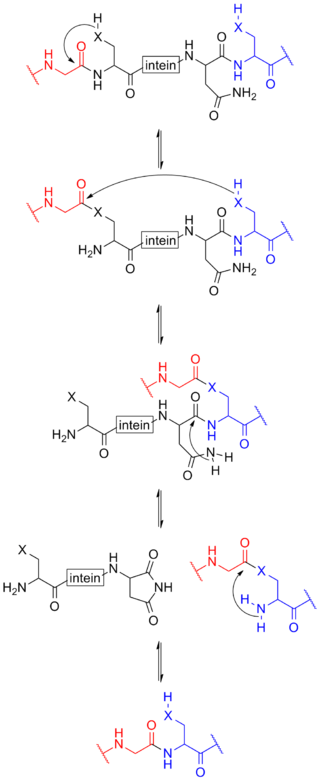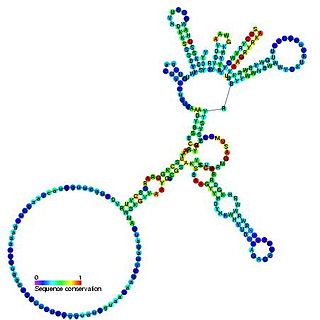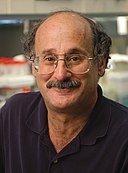Related Research Articles
An intron is any nucleotide sequence within a gene that is not expressed or operative in the final RNA product. The word intron is derived from the term intragenic region, i.e., a region inside a gene. The term intron refers to both the DNA sequence within a gene and the corresponding RNA sequence in RNA transcripts. The non-intron sequences that become joined by this RNA processing to form the mature RNA are called exons.

RNA splicing is a process in molecular biology where a newly-made precursor messenger RNA (pre-mRNA) transcript is transformed into a mature messenger RNA (mRNA). It works by removing all the introns and splicing back together exons. For nuclear-encoded genes, splicing occurs in the nucleus either during or immediately after transcription. For those eukaryotic genes that contain introns, splicing is usually needed to create an mRNA molecule that can be translated into protein. For many eukaryotic introns, splicing occurs in a series of reactions which are catalyzed by the spliceosome, a complex of small nuclear ribonucleoproteins (snRNPs). There exist self-splicing introns, that is, ribozymes that can catalyze their own excision from their parent RNA molecule. The process of transcription, splicing and translation is called gene expression, the central dogma of molecular biology.
Virusoids are circular single-stranded RNA(s) dependent on viruses for replication and encapsidation. The genome of virusoids consists of several hundred (200–400) nucleotides and does not code for any proteins.

Protein splicing is an intramolecular reaction of a particular protein in which an internal protein segment is removed from a precursor protein with a ligation of C-terminal and N-terminal external proteins on both sides. The splicing junction of the precursor protein is mainly a cysteine or a serine, which are amino acids containing a nucleophilic side chain. The protein splicing reactions which are known now do not require exogenous cofactors or energy sources such as adenosine triphosphate (ATP) or guanosine triphosphate (GTP). Normally, splicing is associated only with pre-mRNA splicing. This precursor protein contains three segments—an N-extein followed by the intein followed by a C-extein. After splicing has taken place, the resulting protein contains the N-extein linked to the C-extein; this splicing product is also termed an extein.
A structural gene is a gene that codes for any RNA or protein product other than a regulatory factor. A term derived from the lac operon, structural genes are typically viewed as those containing sequences of DNA corresponding to the amino acids of a protein that will be produced, as long as said protein does not function to regulate gene expression. Structural gene products include enzymes and structural proteins. Also encoded by structural genes are non-coding RNAs, such as rRNAs and tRNAs.
Temperature-sensitive mutants are variants of genes that allow normal function of the organism at low temperatures, but altered function at higher temperatures. Cold sensitive mutants are variants of genes that allow normal function of the organism at higher temperatures, but altered function at low temperatures.

The homing endonucleases are a collection of endonucleases encoded either as freestanding genes within introns, as fusions with host proteins, or as self-splicing inteins. They catalyze the hydrolysis of genomic DNA within the cells that synthesize them, but do so at very few, or even singular, locations. Repair of the hydrolyzed DNA by the host cell frequently results in the gene encoding the homing endonuclease having been copied into the cleavage site, hence the term 'homing' to describe the movement of these genes. Homing endonucleases can thereby transmit their genes horizontally within a host population, increasing their allele frequency at greater than Mendelian rates.

Group I introns are large self-splicing ribozymes. They catalyze their own excision from mRNA, tRNA and rRNA precursors in a wide range of organisms. The core secondary structure consists of nine paired regions (P1-P9). These fold to essentially two domains – the P4-P6 domain and the P3-P9 domain. The secondary structure mark-up for this family represents only this conserved core. Group I introns often have long open reading frames inserted in loop regions.
Johann Peter Gogarten is a German-American biologist studying the early evolution of life. Born in Bad Oeynhausen, Germany, he studied plant physiology and membrane transport with Friedrich-Wilhelm Bentrup in Tübingen and Giessen. In 1987 he moved to the US as a postdoc to work with Lincoln Taiz at UC Santa Cruz. He currently is Distinguished Professor of Molecular and Cell Biology at the University of Connecticut in Storrs, CT.

OLE RNA is a conserved RNA structure present in certain bacteria. The RNA averages roughly 610 nucleotides in length. The only known RNAs that are longer than OLE RNA are ribozymes such as the group II intron and ribosomal RNAs. The exceptional length and highly conserved structure of OLE RNA prompted the hypothesis that OLE RNA could be a ribozyme, or otherwise perform an intricate biochemical task.

The bZIP intron RNA motif is an RNA structure guiding splicing of a non-canonical intron from bZIP-containing genes called HAC1 in yeast, XBP1 in Metazoa, Hxl1 or Cib1 in Basidiomycota and bZIP60 in plants. Splicing is performed independently of the spliceosome by Ire1, a kinase with endoribonuclease activity. Exons are joined by a tRNA ligase. Recognition of the intron splice sites is mediated by a base-paired secondary structure of the mRNA that forms at the exon/intron boundaries. Splicing of the bZIP intron is a key regulatory step in the unfolded protein response (UPR). The Ire-mediated unconventional splicing was first described for HAC1 in S. cerevisiae.
Periannan Senapathy is a molecular biologist, geneticist, author and entrepreneur. He is the founder, president and chief scientific officer at Genome International Corporation, a biotechnology, bioinformatics, and information technology firm based in Madison, Wisconsin, which develops computational genomics applications of next-generation DNA sequencing (NGS) and clinical decision support systems for analyzing patient genome data that aids in diagnosis and treatment of diseases.
The split gene theory is a theory of the origin of introns, long non-coding sequences in eukaryotic genes between the exons. The theory holds that the randomness of primordial DNA sequences would only permit small (< 600bp) open reading frames (ORFs), and that important intron structures and regulatory sequences are derived from stop codons. In this introns-first framework, the spliceosomal machinery and the nucleus evolved due to the necessity to join these ORFs into larger proteins, and that intronless bacterial genes are less ancestral than the split eukaryotic genes. The theory originated with Periannan Senapathy.
Mary P. Edmonds was an American biochemist who made key discoveries regarding the processing of messenger RNA (mRNA). She spent most of her career at the University of Pittsburgh.

The bZIP intron plant is an unconventional bZIP intron in plants located in the mRNA of bZIP60 orthologs. The consensus RNA structure is very similar to the animal variant with short, usually 23 nt intron defined by the loop regions of the conserved hairpins. Majority of the plants contain also a nested spliceosomal intron located at the base of 3’ hairpin. The unconventional splicing in this group is performed by IRE1 in response to ER stress and it was first described in Arabidopsis thaliana.
Charles Clifton Richardson is an American biochemist and professor at Harvard University. Richardson received his undergraduate education at Duke University, where he majored in medicine. He received his M.D. at Duke Medical School in 1960. Richardson works as a professor at Harvard Medical School, and he served as editor/associate editor of the Annual Review of Biochemistry from 1972 to 2003. Richardson received the American Chemical Society Award in Biological Chemistry in 1968, as well as numerous other accolades.
Glauco P. Tocchini-Valentini is an Italian molecular biologist. As of 2009, he was elected as a foreign associate of the National Academy of Sciences, affiliated with the National Research Council of Italy (CNR). In his forty plus years in molecular biology, he has published over 140 papers on topics like mutagenesis, RNA molecules, structure, function and evolution, disease models, neurodegenerative diseases, and cognitive disorders. He currently resides in Rome, Italy as director at the Institute of Cell Biology. He is also the coordinator for European Mouse Mutant Archive, also known as EMMA. Currently, he is actively advocating advancement in infrastructure for science buildings across Europe.

Alan Lambowitz is a professor for the University of Texas at Austin in Molecular Biosciences and Oncology and has been instrumental in many bio-molecular processes and concepts, such as intron splicing and mitochondrial ribosomal assembly.
Benjamin Downs "Ben" Hall was an American human genetics researcher. He was professor of genetics and botany at the University of Washington. Hall is best known for developing methods for producing vaccines and other bio-pharmecuticals using transgenic yeast.
References
- 1 2 "Her South African Alma Mater from the Days of Apartheid Honors Marlene Belfort - University at Albany-SUNY". www.albany.edu. January 21, 2020. Retrieved 2021-10-09.
- ↑ Belfort, Marlene (1973). Involvement of bacterial genotype in bacteriophage lambda's decision between lysogeny and lysis (Thesis). Ann Arbor, Mich.: University Microfilms. OCLC 5455267.
- 1 2 "Marlene Belfort | The Howard P. Isermann Department of Chemical and Biological Engineering". cbe.rpi.edu. Retrieved 2021-10-09.
- ↑ "Marlene Belfort: Stellar Researcher and Mentor - University at Albany-SUNY". www.albany.edu. Retrieved 2021-10-09.
- ↑ Belfort, M.; Maley, G.; Pedersen-Lane, J.; Maley, F. (1983-08-01). "Primary structure of the Escherichia coli thyA gene and its thymidylate synthase product". Proceedings of the National Academy of Sciences. 80 (16): 4914–4918. Bibcode:1983PNAS...80.4914B. doi: 10.1073/pnas.80.16.4914 . ISSN 0027-8424. PMC 384157 . PMID 6308660.
- ↑ Belfort, M.; Maley, G. F.; Maley, F. (1983-04-01). "Characterization of the Escherichia coli thyA gene and its amplified thymidylate synthetase product". Proceedings of the National Academy of Sciences. 80 (7): 1858–1861. Bibcode:1983PNAS...80.1858B. doi: 10.1073/pnas.80.7.1858 . ISSN 0027-8424. PMC 393709 . PMID 6340111.
- ↑ Chu, F. K.; Maley, G. F.; Maley, F.; Belfort, M. (1984-05-01). "Intervening sequence in the thymidylate synthase gene of bacteriophage T4". Proceedings of the National Academy of Sciences. 81 (10): 3049–3053. Bibcode:1984PNAS...81.3049C. doi: 10.1073/pnas.81.10.3049 . ISSN 0027-8424. PMC 345218 . PMID 6328492.
- ↑ Belfort, M; Pedersenlane, J; West, D; Ehrenman, K; Maley, G; Chu, F; Maley, F (1985). "Processing of the intron-containing thymidylate synthase (td) gene of phage T4 is at the RNA level". Cell. 41 (2): 375–382. doi:10.1016/S0092-8674(85)80010-6. PMID 3986907. S2CID 27127017.
- ↑ BELFORT, M; PEDERSENLANE, J; WEST, D; EHRENMAN, K; MALEY, G; CHU, F; MALEY, F (1985). "Processing of the intron-containing thymidylate synthase (td) gene of phage T4 is at the RNA level". Cell. 41 (2): 375–382. doi:10.1016/s0092-8674(85)80010-6. ISSN 0092-8674. PMID 3986907. S2CID 27127017.
- ↑ Belfort, Marlene; Weiner, Alan (1997). "Another Bridge between Kingdoms: tRNA Splicing in Archaea and Eukaryotes". Cell. 89 (7): 1003–1006. doi: 10.1016/S0092-8674(00)80287-1 . PMID 9215622. S2CID 16611946.
- ↑ Chu, Frederick K.; Maley, Gladys F.; West, Deborah K.; Belfort, Marlene; Maley, Frank (1986). "Characterization of the intron in the phage T4 thymidylate synthase gene and evidence for its self-excision from the primary transcript". Cell. 45 (2): 157–166. doi:10.1016/0092-8674(86)90379-x. ISSN 0092-8674. PMID 3698096. S2CID 938805.
- ↑ Shub, D. A.; Gott, J. M.; Xu, M. Q.; Lang, B. F.; Michel, F.; Tomaschewski, J.; Pedersen-Lane, J.; Belfort, M. (1988-02-01). "Structural conservation among three homologous introns of bacteriophage T4 and the group I introns of eukaryotes". Proceedings of the National Academy of Sciences. 85 (4): 1151–1155. Bibcode:1988PNAS...85.1151S. doi: 10.1073/pnas.85.4.1151 . ISSN 0027-8424. PMC 279724 . PMID 3422485.
- ↑ Ehrenman, K.; Pedersen-Lane, J.; West, D.; Herman, R.; Maley, F.; Belfort, M. (1986-08-01). "Processing of phage T4 td-encoded RNA is analogous to the eukaryotic group I splicing pathway". Proceedings of the National Academy of Sciences. 83 (16): 5875–5879. Bibcode:1986PNAS...83.5875E. doi: 10.1073/pnas.83.16.5875 . ISSN 0027-8424. PMC 386399 . PMID 3526343.
- ↑ Lambowitz, Alan M.; Belfort, Marlene (1993). "Introns as Mobile Genetic Elements". Annual Review of Biochemistry. 62 (1): 587–622. doi:10.1146/annurev.bi.62.070193.003103. ISSN 0066-4154. PMID 8352597.
- ↑ Bryk, Mary; Belfort, Marlene (1990). "Spontaneous shuffling of domains between introns of phage T4". Nature. 346 (6282): 394–396. Bibcode:1990Natur.346..394B. doi:10.1038/346394a0. ISSN 0028-0836. PMID 2197562. S2CID 4365330.
- ↑ Belfort, Marlene; Perlman, Philip S. (1995). "Mechanisms of Intron Mobility". Journal of Biological Chemistry. 270 (51): 30237–30240. doi: 10.1074/jbc.270.51.30237 . PMID 8530436.
- ↑ Coetzee, T; Herschlag, D; Belfort, M (1994-07-01). "Escherichia coli proteins, including ribosomal protein S12, facilitate in vitro splicing of phage T4 introns by acting as RNA chaperones". Genes & Development. 8 (13): 1575–1588. doi: 10.1101/gad.8.13.1575 . ISSN 0890-9369. PMID 7958841.
- ↑ Wood, David W.; Wu, Wei; Belfort, Georges; Derbyshire, Victoria; Belfort, Marlene (1999). "A genetic system yields self-cleaving inteins for bioseparations". Nature Biotechnology. 17 (9): 889–892. doi:10.1038/12879. ISSN 1087-0156. PMID 10471931. S2CID 13247413.
- ↑ Novikova, Olga; Topilina, Natalya; Belfort, Marlene (2014). "Enigmatic Distribution, Evolution, and Function of Inteins". Journal of Biological Chemistry. 289 (21): 14490–14497. doi: 10.1074/jbc.R114.548255 . PMC 4031506 . PMID 24695741.
- ↑ Li, Zhong; Tharappel, Anil Mathew; Xu, Jimin; Lang, Yuekun; Green, Cathleen M.; Zhang, Jing; Lin, Qishan; Chaturvedi, Sudha; Zhou, Jia; Belfort, Marlene; Li, Hongmin (2021-01-12). "Small-molecule inhibitors for the Prp8 intein as antifungal agents". Proceedings of the National Academy of Sciences. 118 (2): e2008815118. Bibcode:2021PNAS..11808815L. doi: 10.1073/pnas.2008815118 . ISSN 0027-8424. PMC 7812778 . PMID 33397721.
- ↑ "Congratulations to a Nobel Prize winner". www.rfsuny.org. 2017. Retrieved 2021-10-09.
- ↑ Slagter-Jäger, Jacoba G.; Allen, Gregory S.; Smith, Dorie; Hahn, Ingrid A.; Frank, Joachim; Belfort, Marlene (2006-06-27). "Visualization of a group II intron in the 23S rRNA of a stable ribosome". Proceedings of the National Academy of Sciences. 103 (26): 9838–9843. Bibcode:2006PNAS..103.9838S. doi: 10.1073/pnas.0603956103 . ISSN 0027-8424. PMC 1502540 . PMID 16785426.
- ↑ Huang, Tao; Shaikh, Tanvir R.; Gupta, Kushol; Contreras-Martin, Lydia M.; Grassucci, Robert A.; Van Duyne, Gregory D.; Frank, Joachim; Belfort, Marlene (2010-12-03). "The group II intron ribonucleoprotein precursor is a large, loosely packed structure". Nucleic Acids Research. 39 (7): 2845–2854. doi:10.1093/nar/gkq1202. ISSN 1362-4962. PMC 3074136 . PMID 21131279.
- ↑ "Book of Members, 1780-2010: Chapter B" (PDF). American Academy of Arts and Sciences. Retrieved May 30, 2011.
- ↑ "Marlene Belfort". www.nasonline.org. Retrieved 2021-10-09.
- ↑ "The 2000 Excellence Awards". www.albany.edu. Retrieved 2021-10-09.
- ↑ "Past ASM Awardees: ASM Alice C. Evans Award for Advancement of Women" (PDF). June 1, 2020. Retrieved October 9, 2021.
- ↑ "SUNY Distinguished Academy". 2022.
- ↑ Krige, Nadia (December 17, 2019). "'We live in an age where women no longer need to lose out'". www.news.uct.ac.za. Retrieved 2021-10-09.
- ↑ "ASBMB names 2022 award winners". www.asbmb.org. Retrieved 2022-03-16.
- ↑ "2023 RNA Society Lifetime Achievement in Science Award Winner". www.rnasociety.org. Retrieved 2024-01-08.
- ↑ Grondahl, Paul (2020-02-25). "Grondahl: From South Africa's Cape Town, an improbable journey". Times Union. Retrieved 2024-01-08.
- ↑ "Belfort strikes the right balance". www.asbmb.org. Retrieved 2024-01-08.